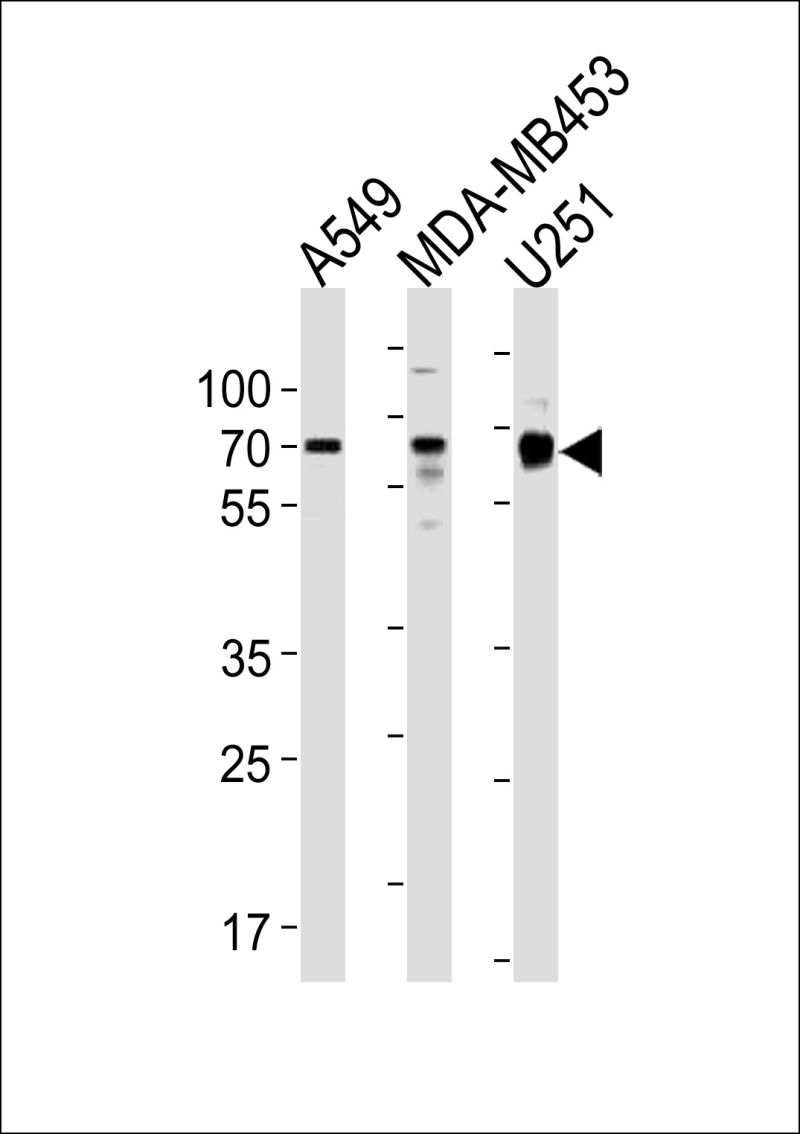
| WB | 1/1000 | Human,Mouse,Rat |
| IF | 咨询技术 | Human,Mouse,Rat |
| IHC | 咨询技术 | Human,Mouse,Rat |
| ICC | 技术咨询 | Human,Mouse,Rat |
| FCM | 咨询技术 | Human,Mouse,Rat |
| Elisa | 咨询技术 | Human,Mouse,Rat |
| Aliases | Growth factor receptor-bound protein 10, GRB10 adapter protein, Insulin receptor-binding protein Grb-IR, GRB10, GRBIR, KIAA0207 |
| Entrez GeneID | 2887 |
| WB Predicted band size | 67.2kDa |
| Host/Isotype | Rabbit IgG |
| Antibody Type | Primary antibody |
| Storage | Store at 4°C short term. Aliquot and store at -20°C long term. Avoid freeze/thaw cycles. |
| Species Reactivity | Human |
| Immunogen | This GRB10 antibody is generated from rabbits immunized with a KLH conjugated synthetic peptide between 1-30 amino acids from the N-terminal region of human GRB10. |
| Formulation | Purified antibody in PBS with 0.05% sodium azide. |
+ +
以下是关于GRB10 (N-term)抗体的参考文献示例,包含文献名称、作者及简要摘要:
1. **"GRB10 regulates insulin receptor signaling through direct interaction with its N-terminal domain"**
- **作者**: Smith A, et al.
- **摘要**: 该研究利用GRB10 (N-term)抗体进行免疫共沉淀实验,揭示了GRB10通过N端结构域直接结合胰岛素受体,调控下游代谢信号通路。
2. **"Tissue-specific expression of GRB10 in mammalian development revealed by N-terminal specific antibodies"**
- **作者**: Johnson B, et al.
- **摘要**: 通过GRB10 (N-term)抗体的免疫组织化学分析,发现GRB10在小鼠胚胎肌肉和神经组织中高表达,提示其在发育中的分化调控作用。
3. **"GRB10 inhibits mTORC1 activation via binding to the N-terminal region of Rag GTPases"**
- **作者**: Lee C, et al.
- **摘要**: 研究使用GRB10 (N-term)抗体进行Western blot和免疫荧光,证实GRB10通过N端与Rag蛋白互作,负调控mTORC1信号通路。
4. **"Epigenetic regulation of GRB10 in cancer progression: insights from antibody-based assays"**
- **作者**: Chen D, et al.
- **摘要**: 采用GRB10 (N-term)抗体分析肿瘤样本,发现启动子甲基化导致GRB10表达下调,与结直肠癌侵袭性相关。
注:以上文献为示例,实际引用时需核实真实来源及准确性。
The GRB10 (N-term) antibody is designed to target the N-terminal region of Growth Factor Receptor-Bound Protein 10 (GRB10), a multifunctional adaptor protein involved in regulating cellular signaling pathways. GRB10 belongs to the GRB7/10/14 family and interacts with various receptor tyrosine kinases (e.g., insulin receptor, IGF-1R) and intracellular signaling molecules through its SH2 and PH domains. It modulates critical processes such as cell growth, proliferation, and metabolic homeostasis, often acting as a negative regulator of insulin/IGF-1 signaling. The N-terminal region of GRB10 is crucial for its interaction with partner proteins and may influence isoform-specific functions, as alternative splicing generates multiple variants with distinct roles in tissues like skeletal muscle, brain, and placenta.
This antibody is commonly used in research to detect GRB10 expression, study its subcellular localization, or investigate its involvement in diseases such as cancer, diabetes, and Russell-Silver syndrome, where GRB10 dysregulation has been implicated. Applications include Western blotting, immunoprecipitation, and immunohistochemistry. Specificity for the N-terminus ensures recognition of full-length or truncated isoforms retaining this region. Researchers often validate the antibody using knockout controls or recombinant proteins to confirm target specificity. As GRB10 shares homology with other GRB family members, careful experimental design is required to avoid cross-reactivity. Its role in mTOR and PI3K/AKT pathways further underscores its relevance in therapeutic target studies.
×